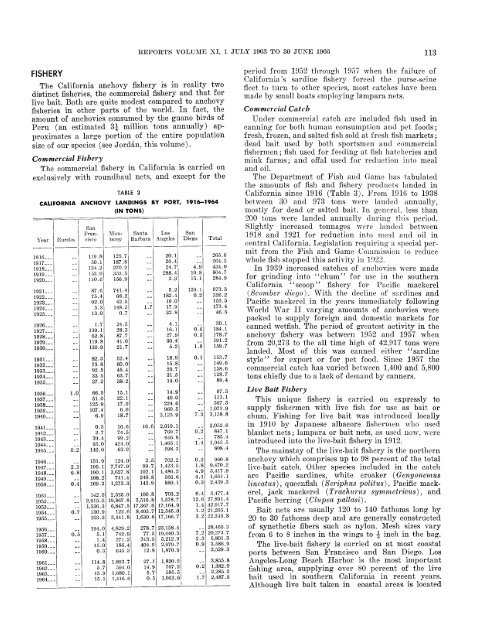CalCOFI Reports, Vol. 11, 1967 - California Cooperative Oceanic ...
CalCOFI Reports, Vol. 11, 1967 - California Cooperative Oceanic ...
CalCOFI Reports, Vol. 11, 1967 - California Cooperative Oceanic ...
Create successful ePaper yourself
Turn your PDF publications into a flip-book with our unique Google optimized e-Paper software.
FISH E RYThe <strong>California</strong> anchovy fishery is in reality twodistinct fisheries, the commercial fishery and that forlive bait. Both are quite modest compared to anchovyfisheries in other parts of the world. In fact, theamount of anchovies consumed by the guano birds ofPeru (an estimated 3% million tons annually) approximatesa large portion of the entire populationsize of our species (see Jordhn, this volume).REPORTS VOLUME SI, 1 JULY 1963 TO 30 JUSE 1966 <strong>11</strong>3period from 1952 through 1937 when the failure of<strong>California</strong>’s sardine fishery forced the purse-seinefleet to turn to other species, most catches have beenmade by small boats employing lampara nets.Commercial CatchUnder commercial catch are included fish used incanning for both human consumption ami pet foods ;fresh. frozen, and salted fish sold at fresh fish markets;dead bait used by both sportsmen and commercialfishermen ; fish used for feeding at fish hatcheries andCommercial Fisherymink farms; and offal used for reduction into mealThe commercial fishery in <strong>California</strong> is carried on and oil.exclusively with roundhaul nets, and except for the The Department of Fish and Ganie has tabulatedthe aniounts of fish and fishery products landed inTABLE 3<strong>California</strong> since 1916 (Table 3). From 1916 to 1938CALIFORNIA ANCHOVY LANDINGS BY PQRT, 1916-1964 between 30 and 973 tons were landed annually,(IN TONS)mostly for dead or salted bait. In general, less than-200 tons were landed annually during this period.Slightly increased tonnages were lanclcd between1918 and 1921 for reduction into meid and oil incentral <strong>California</strong>. Legislation requiring a special pcr-_. <strong>11</strong>9.8 125.7 20.1 __’ mit from the Fish and Game265.6(’oiiiniission 10 reduce__ 50.<strong>11</strong> 187.81 26.4 _. 264.3 whole fish stopped this activity in 1922._. 131.2 270.2 __ 24.7 4.9 434.0 In 1939 increased catches of anchovies were made.. 133 01 352.5 _. 288.4 10.8 801.7_. <strong>11</strong>0.6 156.9 __ 2.3 15.1 284.9 for grinding into “chum” for use in the southern._ 87.6 741.4 __<strong>California</strong> c scoop^' fishery for Pacific mackerel5.2 139.1 973.3_. 75.4 68.2__ 182.4 0.2 326.2 (Xconzber diego). With the decline of sardines and__ 92.0 42.5 __ 19.0 __ 153.5__ 5.3 148.5 1.7 17.9 __Pacific mackerel in the years immediately following173.4_. 13.0 0.7 _ _ 32.8 _. 46.5 World War I1 varying amounts of anchovies werepacked to supply foreign and domestic markets for_. 1.7 24.3 _- 4.1 _. 30.1__ 139.1 28.3 __ 16.1 0.6 184.1 canned wetfish. The period of greatest activity in the__ 62.8 87.7 __ 27.9 0.3 178.7 anchovy fishery was between 1952 and 1957 when__ <strong>11</strong>9.8 41.030.4 _. 191.2__ 130.9 21.7 __ 5.2 1.9 159.7from 20,273 to the all time high of 42,917 tons werelanded. Most of this was canned either ((sardine_. 82.3 52.4 -- 18.’ O.’ 153.7 style” for export or for pet food. Since 1957 the__ 92.5 45.4 _. 20.7 _. 158.6 Commercial catch has varied between 1,400 and 5,800__ 33.5 63.7 __ 31.5 -- 128.7 tons chiefly due to a lack of demand by canners._. 73.8 60.0 __ 15.8 __ 149.6__ 37.2 38.2__ 14.0 _. 89.41.0 66.5 15.1 __ 14.9 __ 97.5 Live Bait Fishery_. 51.0 22.1__ 40.0 __ <strong>11</strong>3.1__ 224.6 __ 367.5This unique fishery is carried on expressly to125.9 17.0__ 107.4 6.0 ._ 960.5 _. 1,073.9 supply fishermen with live fish for use as bait or__ 6.9 18.7 -- 3,125.9 7.3 3,158.8 chum. Fishing for live bait was introduced locally__ 0.3 16.6 16.6 2,019.1 ._ 2,052.6 in 1910 by Japanese albacore fishermen who used_. 2.7 74.5 -- o.2 847.1 blanket nets; lampara or bait nets, as used now, Tl-ere_. 39.4 99.2__ 646.8 785.4__ 55.0 424.0 .. 1,465.1 1:4 1,945.5 introduced into the live-bait fishery in 1912.0.2 146.0 63.9 __ 598.3 _. 808.4The mainstay of the live-bait fishery is the northern__ 131.9 124.0 2.5 702.2 0.2 960.8 anchovy which comprises up to 98 percent of the total2.2 195.1 7,747.9 99.7 1,423.5 1.8 9,470.2live-bait catch. Other specks included in the catch6.8 190.1 3,627,8 102,1 1,486,2 4,9 5,417.9__ 108.2 741.4 240.8 566.6 4.1 1,661.1 are Pacific sardines, white croaker (Genyonenaus0.4 169.3 1,273.3 143.9 850.1 0.3 2,439.3 lineatus), queenfish (Xeriphics politus), Pacific mack-__ 142.0 2,525.0 100.8 703.2 6.43,477.4 erel, jack mackerel (!kXh?crzcs syqnnzetricus), and__ 2,915.5 19,867.8 3,516.8 1,578.7 12.6 27391.4 Pacific herring (Clupea pdusi).__ 1,536.3 6,847.5 17,367.6 17,164.9 1.4 42,917.70.7 130.9 122.6 8,403.7 12,546.0 1.2 21,205.1 Bait nets are usually 120 to 140 fathoms long by-- 103.3 3,441.8 1,630.8 17*166.7 3.2 223345.8 20 to 30 fathoms deep and are generally constructed__ 194.0 4,829.2 278.7 23,158.4 .. 28,460.3 of synethetic fibers such as nylon. Mesh sizes vary0.5 5.1 742.9 77.5 199440.5 7.2 20,273.7 from 6 to 8 inches in the wings to 4 inch in the bag.__ 1.4 271.2 313.5 5,212.9 2.3 5,801.315.0 186.4 404.9 2,979.7 0.9 3,586.9 The live-bait fishery is carried on at most coastal__ 0.3 645.3 12.8 1,870.9 __ 2,529.3norts between San Francisco and San Diego. LosL----- -~__ <strong>11</strong>4.8 1,893.7 27.1 1,820.2 -- 3,855.8 Rngeles-Long Beach Harbor is the most imiortant_. 5.7 594.0 14.9 767.2 0.2 2,285.2 1382.0 fishing area, supplying over 80 percent of the h e_. 13.9 1,680.1 5.7 585.515.1 1,416.6 0.5 1,053.6 I:? 2,487.5 bait used in southern <strong>California</strong> in recent years.Although live bait taken in coastal areas is locatedj ..















